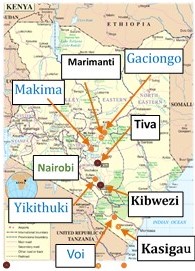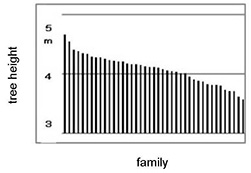Home > International Partnerships > Collaborative Research > Development of Drought-Tolerant Trees as an Adaptation to Climate Change in Dryland Kenya
Update:March 2, 2020
Main content starts here.
Development of Drought-Tolerant Trees as an Adaptation to Climate Change in Dryland Kenya

1. Partners
Kenya Forestry Research Institute (KEFRI), Kenya
Kenya Forest Service (KFS), Kenya
Kyushu University, Japan
2. Research Period
July 2012-June 2017 JICA Technical Cooperation Project
3. Lead Researcher
UBUKATA, Masatoshi
4. Background
Arid and semi-arid lands (ASALs) account for 80% of Kenya’s land area, while the forest area occupies only 7% of the land according to a KFS report published in 2010. Approximately 70% of the energy that is consumed in Kenya is produced from fuelwood, which places considerable pressure on these limited forest resources. Furthermore, the immigration of farmers from other areas into the ASALs in recent years is accelerating the degradation of the forest resources and soils and affecting the livelihoods of the local people, who are heavily dependent on these natural resources.
The Japan International Cooperation Agency (JICA) currently gives top priority to assisting Kenya with environmental conservation and has collaborated with Kenya in forest conservation in the ASALs for more than 20 years. Through this collaboration, the KFS has strengthened its system for implementing social forestry and techniques for establishing farm forests have been smoothly extended to farmers. At the same time, Melia volkensii and Acacia tortilis have become recognized as the most important tree species due to their fast growth and multiple uses. However, an increased strength and frequency of droughts would reduce the amount of suitable areas for planting these species in the future.
In view of this, the Government of Kenya has officially requested technical cooperation by the Government of Japan on the “Project on Development of Drought Tolerant Trees for Adaptation to Climate Change in Drylands of Kenya.” In response to this request, this JICA technical cooperation project was carried out over the 5 years from 2012 to 2017 to increase the capacity for tree breeding research and to establish a system for extending the improvement of seeds of indigenous species, with guidance from long- and short-term experts from the Forest Tree Breeding Center (FTBC) in Japan.
5. Research Goal
The aim of this project was to enhance the research capacity and extend the system that is necessary to promote indigenous species plantations in the ASALs by:
1) Strengthening KEFRI’s capacity to conduct research on the genetic diversity of indigenous species (M. volkensii and A. tortilis as an initial trial).
2) Strengthening KEFRI’s capacity to implement the breeding of indigenous species of forest trees (M. volkensii and A. tortilis as an initial trial).
3) Establishing a quality seed and seedling supply system for M. volkensii.
4) Increasing the awareness of relevant stakeholders about the importance of using quality seeds and seedlings.
6. Research Strategy
This research aimed to establish a comprehensive breeding system for drought-tolerant tree species. The breeding procedure mainly consisted of the following activities:
A) Select candidate plus trees as breeding materials.
B) Propagate clonal seedlings of these plus trees and establish clonal seed orchards.
C) Establish a progeny test stand to identify the characteristics of each variety.
D) Select superior species based on their characteristics (drought tolerance, etc.).
For M. volkensii, we selected 100 clones from its growing area in Kenya and established two clonal seed orchards and 12 progeny test sites (PTSs) (Fig. 1), following which we analyzed tree growth at each site. For A. tortillis, we also selected 100 clones, but in this case established two seed stands and two PTSs. KEFRI-FTBC analyzed the DNAs of both species to collect basic information for the production and distribution of seeds for local residents and to ensure biodiversity and biodifferences.
7. Scientific Achievement
Analysis of the data from the M. volkensii PTSs showed that there was a more than 1-m difference in average tree height between different families at 18 months after planting (Fig. 2). Consequently, one of the project members provided technical guidance to KEFRI staff around appropriate measures to improve the seed orchard, which involved treating the trees of inferior clones with stem cutting and branch pruning. We also measured the precipitation, stem growth, phenology, and photosynthesis volume of the M. volkensii trees in the PTSs to establish a drought tolerance standard, which indicated that the faster-growing clone may have a greater rate of photosynthesis and produce longer leaves.
The experts from FTBC promoted the propagation techniques and nursery management skills of KEFRI staff from a basic level to ensure the quality of the planting materials being provided, as the project plans to undertake many planting activities, such as the establishment of a clonal seed orchard, a progeny test field, a seed stand, and a demonstration forest.
We also gathered location/environmental data for M. volkensii and A. toritillis from across Kenya and integrated this information into a Geographic Information System (GIS) database, which showed that although there was little genetic diversity between populations of M. volkensii in Kenya, there were clear genetic differences between the northern, central, and southern regions. The results of this research were used to develop “The guideline for the conservation of genetic resources of Melia volkensii and Acacia tortilis.”

Fig. 1 Locations of the Melia volkensii clonal seed orchard and progeny test sites (PTSs) and the Acacia tortilis seed stands. The M. volkensii clonal seed orchard and PTSs were established in Tiva and Kibwezi, while other PTSs and sub-PTSs were established at the other sites.

Fig. 2 Tree heights of different families of Melia volensii at the different progeny test sites (PTSs). There was a difference in average tree height of more than 1 m between the families at 18 months after planting.
8. Applications
Seed production has now started in two clonal seed orchards and KEFRI has provided the improved M. volensii seed to Kenyan residents. This research will not only contribute to afforestation in Kenya but will also be disseminated to neighboring countries such as Tanzania and Uganda.
9. Publications
Hanaoka So, Gabriel M Muturi, Atsushi Watanabe, Isolation and characterization of microsatellite markers of Melia volkensii Gurke. Conservation Genetics Resources, 4:395-398, 2012
Hanaoka So, Norio Nakawa, Norihisa Okubo, Stephen Frederick Omondi, Jason Kariuki, Seed pretreatment methods for improving germination of Acacia tortilis. African Journal of Biotechnology, 13(50): 4557-4561, 2014
Stephen Frederic Omondi, Joseph Machua, John Gicheru, So Hanaoka, Isolation and characterization of microsatellite markers for Acacia tortilis (Forsk.) Hayne. Conservation Genetics Resources, Volume 7, 529–531, 2015
Hisaya Miyashita, James K. Ndufa, Variation of wood density in the plus tree clones of Melia volkensii selected from drylands of Kenya, International Symposium on Wood Science and Technology 2015
Nellie Mugure Oduor, Hisaya Miyashita, Basic density in Melia volkensii, International Symposium on Wood Science and Technology 2015
Hanaoka S, Ohira M, Matsushita M, Kariuki J, Optimizing the size of root cutting in Melia volkensii Gurke for improving clonal propagation and production of quality planting stock. African Journal of Biotechnology. 15: 1551-1558, 2016
Copyright © Forest Research and Management Organization. All rights reserved.
